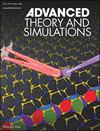无机新型立方卤化物钙钛矿Ca3AsX3 (X = Br, I)结构、声子、力学、光电、光伏、热电和热力学性质的第一性原理计算
IF 2.9
4区 工程技术
Q1 MULTIDISCIPLINARY SCIENCES
引用次数: 0
摘要
无铅卤化物钙钛矿因其相关性质而引起了研究人员的极大兴趣。本文利用WIEN2k程序中的密度泛函理论计算,研究了Ca3AsX3(X = Br, I)的结构、声子、力学、电子、光学、光伏、热电和热力学性质。经过对其相稳定性的广泛研究,所有化合物都证明了其热力学和动力学稳定。用地层能量检验热力学稳定性,用声子色散检验动力学稳定性。这些化合物的结构稳定性通过弹性常数的检验得到了证实。结果表明,Ca3AsBr3和Ca3AsI3均表现出半导体性质,对应的带隙能量分别为2.45和1.94 eV。其相应的带隙能量和显著的光吸收使其成为光伏和光电子应用的绝佳选择。通过性能图、塞贝克系数、功率因数PF和其他热电特性证明了Ca3AsX3在热电器件中的增强利用率。Ca3AsX3(X = Br, I)由于其外量子效率和13和20.66 mA的短路电流,在太阳能工业中具有优势。厘米−2分别。研究了温度对化合物的熵、自由能、焓和热容的影响。这意味着Ca3AsX3(X = Br, I)化合物可能为热电、光电和光伏系统的研究开辟新的途径。本文章由计算机程序翻译,如有差异,请以英文原文为准。

First Principles Calculations of Structural, Phonon, Mechanical, Optoelectronic, Photovoltaic, Thermoelectric and Thermodynamic Properties of Inorganic Novel Cubic Halide Perovskites Ca3AsX3 (X = Br, I) a DFT Study
Lead-free halide perovskites have garnered a lot of interest in researchers because of their pertinent properties. This paper examined the structural, phonon, mechanical, electronic, optical, photovoltaic, thermoelectric, and thermodynamic properties of Ca3AsX3(X = Br, I) using density functional theory calculations executed in the WIEN2k program. All of the compounds have been shown to be thermodynamically and dynamically stable after extensive investigation into their phase stability. The thermodynamic stability is checked using formation energy, and the dynamical stability is checked using phonon dispersion. These compounds' structural stability is confirmed by the examination of the elastic constant. Based on the results, Ca3AsBr3 and Ca3AsI3 all demonstrate semiconducting behavior, with corresponding bandgaps energies of 2.45 and 1.94 eV respectively. Their corresponding bandgap energies and significant optical absorption make them great options for photovoltaic and optoelectronic applications. Enhanced Ca3AsX3 utilization in thermoelectric devices is demonstrated by the figure of merit, Seebeck coefficient, power factor PF, and other thermoelectric characteristics. Ca3AsX3(X = Br, I) are advantageous in the solar industry due to its external quantum efficiency and short-circuit current of 13 and 20.66 mA.cm−2 respectively. The effect of temperature on the compound's entropy, free energy, enthalpy, and heat capacity is investigated in the study. This implies that Ca3AsX3(X = Br, I) compounds may open up new avenues for thermoelectric, optoelectronic, and photovoltaic system research.
求助全文
通过发布文献求助,成功后即可免费获取论文全文。
去求助
来源期刊

Advanced Theory and Simulations
Multidisciplinary-Multidisciplinary
CiteScore
5.50
自引率
3.00%
发文量
221
期刊介绍:
Advanced Theory and Simulations is an interdisciplinary, international, English-language journal that publishes high-quality scientific results focusing on the development and application of theoretical methods, modeling and simulation approaches in all natural science and medicine areas, including:
materials, chemistry, condensed matter physics
engineering, energy
life science, biology, medicine
atmospheric/environmental science, climate science
planetary science, astronomy, cosmology
method development, numerical methods, statistics
 求助内容:
求助内容: 应助结果提醒方式:
应助结果提醒方式:


